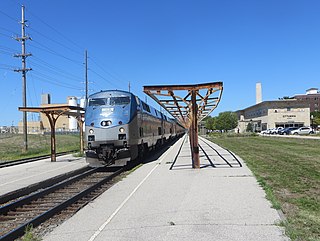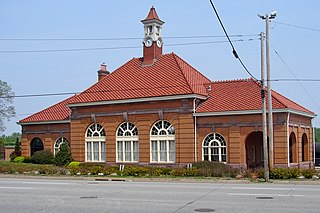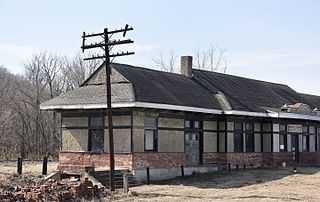
St. Francois County is a county located in the Lead Belt region in the U.S. state of Missouri. As of the 2020 census, the population was 66,922. The largest city and county seat is Farmington. The county was officially organized on December 19, 1821. It was named after the St. Francis River. The origin of the river's name is unclear. It might refer to St. Francis of Assisi. Another possibility is that Jacques Marquette, a Jesuit who explored the region in 1673, named the river for the Jesuit missionary Francis Xavier. Marquette had spent some time at the mission of St. Francois Xavier before his voyage and, as a Jesuit, was unlikely to have given the river a name honoring the Franciscans.

Bonne Terre is a city in St. Francois County, Missouri, United States with a population of 6,864 at the 2010 census. Situated in the Southeast Missouri Lead District, lead mining shaped the history and character of the area from the earliest French settlers in the 1720´s until today, even though Bonne Terre Mine established by St. Joseph lead mining company in 1864 closed in 1962. Mine tailing piles eroded, and contaminated the area as dust, posing residential hazards or were washed into the Big River. Only in 1992, the Bonne Terre Mine Tailings Site was listed as a Superfund Site; as of 2022 remediation is still ongoing.

Potosi is a city in Washington County, Missouri, United States. Potosi is seventy-two miles southwest of St. Louis. The population was 2,660 as of the 2010 census. It is the county seat of Washington County. The city was founded in 1763 as "Mine à Breton" or Mine au Breton, and later renamed by Moses Austin for the Bolivian silver-mining city of Potosí.

The Southeast Missouri Lead District, commonly called the Lead Belt, is a lead mining district in the southeastern part of Missouri. Counties in the Lead Belt include Saint Francois, Crawford, Dent, Iron, Madison, Reynolds, and Washington. Philip Francois Renault of France led a large exploratory mission in 1719 and started mining operations in Old Mines and Mine La Motte in 1720. The town of Sainte Genevieve was founded as a river port for transportation of lead out of the area. Moses Austin started large-scale mining and smelting at Potosi, originally known as Mine a Breton, and founded Herculaneum as his shipping point on the Mississippi. This lead was originally used as a roofing material. Bonne Terre has large subterranean mines, now used commercially for recreational scuba diving.

Ottumwa station is an Amtrak intercity train station in Ottumwa, Iowa, United States. The station was originally built by the Chicago, Burlington and Quincy Railroad, and has been listed as Burlington Depot by the National Register of Historic Places since November 26, 2008. It became a contributing property in the Historic Railroad District in 2011.

The Atchison, Topeka and Santa Fe Passenger and Freight Complex is a nationally recognized historic district located in Fort Madison, Iowa, United States. It was listed on the National Register of Historic Places in 1992. At the time of its nomination it contained three resources, all of which are contributing buildings. The buildings were constructed over a 24-year time period, and reflect the styles that were popular when they were built. The facility currently houses a local history museum, and after renovations a portion of it was converted back to a passenger train depot for Amtrak, which opened on December 15, 2021.

The Chicago, Rock Island and Pacific Railroad Passenger Station is a historic building located in Iowa City, Iowa, United States. Built in 1898 for passenger use, it was the second depot in the city. The first one was built by the Mississippi and Missouri Railroad, a predecessor of the Chicago, Rock Island and Pacific Railroad (CRI&P), in 1855. This one was built through the efforts of Harry Breene, the local Rock Island agent. W.K. McFarlin, CRI&P's superintendent of maintenance and construction oversaw the building's construction. Architecturally, it is a combination of the Richardsonian Romanesque and Victorian Romanesque. The depot was built to similar designs of stations in Ottawa, Illinois, and Council Bluffs, Iowa.
St. Joe Minerals Corporation was an American mining company. It was the United States largest producer of lead and zinc at the time of its merger with Fluor Corporation in 1981. The St. Joseph Lead Company was founded on March 25, 1864 by Lyman W. Gilbert, John E. Wylie, Edmund I. Wade, Wilmot Williams, James L. Dunham and James L. Hathaway in New York City.

The Rock Island Lines Passenger Station, also known as Abbey Station, is an historic building located in Rock Island, Illinois, United States. It ceased operating as a railway station in 1980. The building was listed on the National Register of Historic Places in 1982, and it was designated a Rock Island landmark in 1987.

The Missoula station in Missoula, Montana, was built by the Northern Pacific Railway in 1901. The current structure is the third depot built in Missoula by the Northern Pacific, which reached Missoula in 1883. It was listed on the National Register of Historic Places in 1985, as the Northern Pacific Railroad Depot.

The Missouri-Pacific Depot, Ozark, now the Ozark Area Depot Museum, is a historic railroad station and museum at 1st and River Streets in Ozark, Arkansas. It is a roughly rectangular stone structure with a hip roof, standing between River Street and the railroad tracks. On its southern (rail-facing) side a telegrapher's booth projects. The roof has broad eaves extending around the building, supported by large Craftsman-style knee braces, and with exposed rafters visible. The station was built in 1910 by the Missouri-Pacific Railroad, and is notable for its association with the economically important railroad, and for its fine Craftsman architecture. It is now a local history museum.

Keokuk Union Depot is an historic train station on the west bank of the Mississippi River near downtown Keokuk, Iowa, United States. It was built from 1890 to 1891, and it was listed on the National Register of Historic Places in 2013.

The Missouri Pacific Depot is a historic railroad station at Market and Ramey Streets in Bald Knob, Arkansas. It is a rectangular single-story structure, framed in wood and finished in brick, with a broad shallow-pitch hip roof. The northern side of the roof, where passengers waited, is supported by brick posts and has large L-shaped brackets. Built in 1915, it is Bald Knob's second railroad station, a reminder of the role the railroad played in the city's development.

Magnolia station is a historic railway station located at 101 E. Railroad Avenue, in Magnolia, Mississippi. The depot was placed on the National Register of Historic Places in 1984 as The Depot and was designated a Mississippi Landmark in 2006.

Missouri Pacific Depot is a historic train station located at Charleston, Mississippi County, Missouri. It was built in 1916-1917 by the Missouri Pacific Railroad, and is a one-story, rectangular brick building with white, smooth-cut limestone wainscotting. The building measures 24 feet by 149 feet, 4 inches. It had a red tile hipped roof with a seven foot wide overhang.

Louisiana Chicago & Alton Railroad Depot, also known as the II Central Gulf, Burlington Northern, Gateway Western Railway Depot, is a historic train station located at Louisiana, Pike County, Missouri. It was built in 1907-1908 by the Chicago & Alton Railroad, and is a one-story, Mission Revival style red brick and stucco building. The rectangular building has a gable on hip roof with projected eaves and exposed wooden roof rafter. The depot continued to operate until 1967.
St. Joe Lead Company Administration Building, also known as the St. Joe Company Offices, Central Office Building, is a historic office building located at Bonne Terre, St. Francois County, Missouri. It was built in 1909 by the St. Joe Lead Company, and is a 2 1/2-story, "H"-shaped, Gothic Revival style brick building with granite trim. It features pointed arched entrances, bay windows and bi-chromatic decoration.

Bonne Terre Mine, also known as the St. Joseph Lead Mine at Bonne Terre, is a historic lead mine located at Bonne Terre, St. Francois County, Missouri.

Sikeston St. Louis, Iron Mountain and Southern Railway Depot, also known as the Sikeston Missouri Pacific Railroad Depot, is a historic train station building located at Sikeston, Scott County, Missouri. It was built in 1916-1917 by the St. Louis, Iron Mountain and Southern Railway, and is a one-story, rectangular brick building measuring 24 feet by 100 feet. It has a hipped, red ceramic tile roof with wide eaves supported by curvilinear brackets. It houses a local history museum.

The Mississippi River & Bonne Terre Railway was a single-track standard-gauge steam railroad that was located in southeastern Missouri and began service in 1892. It extended from Riverside in a general southwesterly direction to the lead-mining field in St. Francois County. The main stem, from Riverside to Doe Run, was 46.492 miles (74.822 km) long. Eight short branch lines had a total trackage of 17.418 miles (28.032 km). Sidings and spurs aggregated 30.664 miles (49.349 km), and all tracks owned 94.574 miles (152.202 km).






















